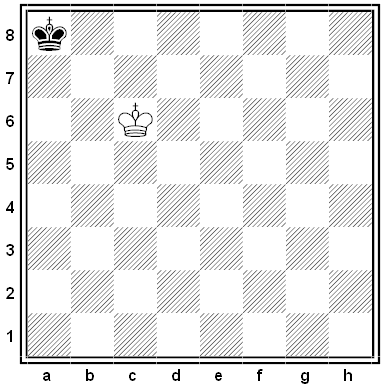
A.G. Buchanan posed this curious puzzle in The Problemist in July 2001. Who moved last? The question seems absurd. If each side has only a bare king, how can we know which made the last move?
The answer turns on Rule 5.2b in the Laws of Chess:
The game is drawn when a position has arisen in which neither player can checkmate the opponent’s king with any series of legal moves. The game is said to end in a ‘dead position.’ This immediately ends the game, provided that the move producing the position was legal.
In the position above, suppose it was Black who moved last. He cannot simply have moved his king to the corner from a7 or b8, because in that earlier position Rule 5.2b would already have applied: The game would have ended in a draw at that point, and Black would have had no opportunity to move his king to a8. Similarly, Black cannot have captured a knight or a bishop on a8, because neither of those pieces (alone with a king) is sufficient to give checkmate, and again the game would have ended before the diagrammed position could be reached.
Black might have captured a rook or a queen on a8. But consider that case: Suppose there was a queen on a8, and the black king was in check on a7 or b8. In that case the capture was forced — Black had no other legal move. And hence even before the capture took place it would have been correct to say that “neither player can checkmate” — the capture was ordained and no possible mate lay in the future. And so the game would have ended at that point, and again we could never have reached the diagrammed position.
Hence Black has no possible legal last move, and the answer to the puzzle is that White moved last, capturing a black piece on c6. Because this capture wasn’t forced, Rule 5.2b is not invoked.
This is a technicality, but it’s an important one. In 2015 the World Federation of Chess Composition voted that the “dead position” rule applies only to retrograde (backward-looking) problems like the one above. More details are here.
